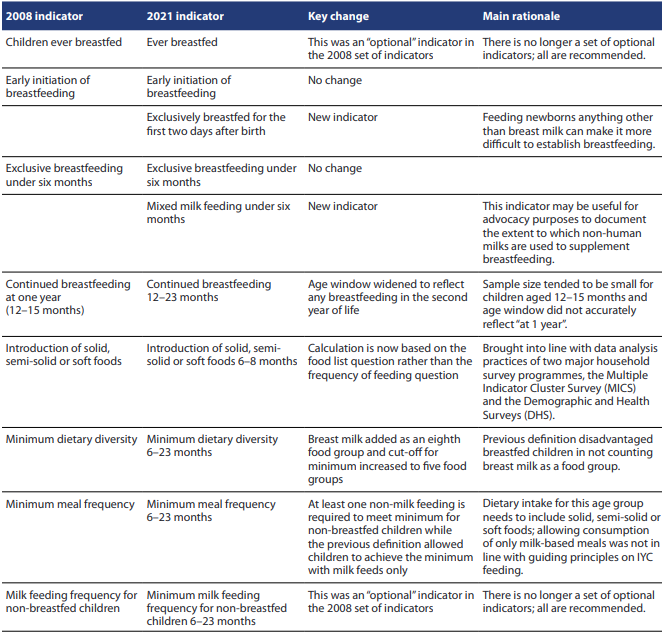In April 2021, WHO and UNICEF released updated definitions and measurement guidance for indicators to assess infant and young child feeding (IYCF) practices. Originally released in 2008, indicators of diet quality for children 0-23 months of age have been an essential tool for policy makers and program planners within and across low- and middle- income countries (LMICs). The indicators, which in many LMICs are included in high-level monitoring frameworks and collected through household surveys, provide essential information to support problem identification, advocacy, intervention design, program implementation, and monitoring and evaluation.
The updated IYCF indicator guidance also illustrates important principles for how the nutrition community can approach prioritization, development, revision and dissemination of other indicators intended for use by a range of nutrition stakeholders. This blog post lists recommendations on how the nutrition community can improve other aspects of nutrition data based on the IYCF guideline update.
What’s new?
First, the update is unique in that it revisits well-established measurement guidance to address some of the shortcomings identified by users over the last decade. One example is the revision of the “Minimum Dietary Diversity” (MDD) indicator to include breastmilk as an eighth food group. The previous 7-group MDD indicator definition was technically correct in its focus on complementary foods but required separate estimates for breastfed and non-breastfed children which made interpretation difficult. Several other IYCF indicator definitions were also revised; changes are clearly summarized in the guidance.
Recommendation: There are a number of “problematic” indicators commonly used by nutrition community that would benefit from systematic review and update based on user experience (e.g. vitamin A; iron-folic acid supplementation coverage).
Second, the updated IYCF indicators reflect user demand for new information, particularly more information on unhealthy diets in young children. WHO and UNICEF convened several expert consultations to inform how to operationalize new indicators related to consumption of foods high in sugar, salt and/or unhealthy fats and no consumption of fruits and vegetables. As with the original 2008 indicators, adjustments to these unhealthy diet indicators will likely be needed over time, but it’s important that countries start collecting and using this information as quickly as possible.
Recommendation: For domains where indicators do not yet exist, an expert consultative approach can help catalyze indicator development and uptake. DataDENT is using this approach to propose new indicators and tools to measure coverage of nutrition sensitive social protection interventions.
Finally, the update of the IYCF indicators has spurred efforts to address methodological challenges with wider implications. Compared to the 2008 version, the updated guidance provides more clarification on methodological issues. The guidance highlights the differences and trade-offs between “open” and “list” based approaches to identify food groups consumed in the previous 24 hours. While not specifically recommended in the updated IYCF guidance, there have been a number of complementary efforts to systematically test the open and list-based approaches using the MDD-W. These efforts include studies conducted by the FAO in Zambia and Ethiopia which were highlighted in a Data for Nutrition webinar in December 2020. There are also efforts to identify country-specific sentinel foods that can be used in place of broader food group.
Recommendation: Investment in validating and improving methods for data collection is essential.
Now that the new indicators are officially released it’s important that the nutrition community is made aware of the changes and works together to ensure they are used. The new indicators have implications for global and country-level monitoring and targets which are reflected in DataDENT-supported analysis comparing old and new MDD definitions. We already see some progress towards filling data gaps. In 2019, The DHS Program accepted the recommendation submitted by DataDENT and partners to include the updated IYCF indicators in the DHS-8, which launched in 2020.

Table 2: Changes between the 2008 and 2021 IYCF indicators (Indicators for assessing infant and young child feeding practices: Definitions and measurement methods, 2021)

Table 2: Changes between the 2008 and 2021 IYCF indicators (Indicators for assessing infant and young child feeding practices: Definitions and measurement methods, 2021)
